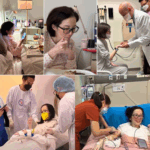A Gentle Reminder: Safe Sleep Habits Matter Beyond Infancy
Introduction
In a heartbreaking incident that recently drew widespread attention, a one-year-old child was found unresponsive after being put to sleep in a face-down position. Despite immediate medical intervention, the child could not be revived. Medical professionals later pointed to aspiration pneumonia as the likely cause—a condition that occurs when a person inhales food, liquid, or vomit into the lungs.
Although this situation is tragic, it serves as a vital reminder for parents, guardians, and caregivers that sleep safety does not end with infancy. Toddlers, just like newborns, are vulnerable to risks associated with unsafe sleep practices. The intention of this article is not to instill fear but to offer helpful, practical, and life-saving guidance grounded in medical recommendations and recent case learnings.
Understanding What Happened
The child in question had reportedly vomited while asleep in a prone (face-down) position. Medical evaluation revealed that the vomit had been aspirated into the lungs—leading to an infection and respiratory complications. Unfortunately, the child did not recover, and doctors emphasized that the sleeping position likely played a crucial role in the outcome.
This situation isn’t isolated. Over the years, medical researchers and pediatric health advocates have urged caregivers to maintain proper sleep positioning and safety practices, not only for infants under one year old but also for toddlers.
The Hidden Risks of Face-Down Sleeping
The prone sleeping position can create several risks for infants and toddlers alike. While many toddlers may appear to have more control over their bodies compared to newborns, they are still vulnerable—especially when sick, tired, or experiencing reflux.
Some of the most notable risks include:
Airway obstruction: A child’s nose and mouth may press against a mattress, pillow, or soft bedding, blocking airflow.
Aspiration: If a toddler vomits and is unable to lift or turn their head, fluids can enter the lungs.
Delayed response reflexes: Children in early developmental stages may not have the reflexes necessary to reposition themselves in distress.
Soft surfaces: Items such as pillows, comforters, or even padded toys can create barriers that restrict breathing.
Age Does Not Eliminate Risk
There’s a widespread but incorrect belief that once a child passes the infant stage, they’re automatically safe from sleep-related risks. This assumption has led many caregivers to become more relaxed about sleep positions and bedding safety. However, several recent cases and expert findings suggest otherwise.
In fact, studies have shown that accidental suffocation, positional asphyxia, and aspiration can still occur well into toddlerhood if proper precautions are not taken.
Safe Sleep Recommendations for Toddlers
To minimize the risk of sleep-related complications in toddlers, pediatric experts and health organizations have developed and promoted several key recommendations:
-
Back to Sleep: Always place children on their backs to sleep, even if they are over 12 months old.
Use Firm Surfaces: Choose a crib or mattress that is firm and fits tightly within the crib frame. Avoid couches, bean bags, or soft bedding.
Remove Pillows and Loose Items: Do not include pillows, thick blankets, stuffed animals, or bumper pads in your child’s sleeping area.
Avoid Overheating: Dress your child in light sleepwear and maintain a comfortable room temperature.
Stay Observant: Especially during naps or when a child is sick, remain nearby or use a baby monitor for supervision.
Be Mindful After Meals: Avoid placing your toddler down for a nap immediately after feeding, and watch for signs of reflux.
When Sleep Turns Risky: Real-Life Cases
While it’s difficult to discuss, understanding what has happened in similar cases can help others prevent tragedy. Here are a few notable incidents from various countries where prone sleeping was a significant factor:
A toddler in Southeast Asia was placed on a soft mattress for a nap. He had recently eaten and vomited during sleep, but his prone position made it difficult for him to clear his airway in time.
In another case, a caregiver placed a baby face-down on a pillow for a nap. The child was later found unresponsive. The coroner’s report emphasized the importance of proper sleep positions and bedding.
At a childcare facility, a nine-month-old was left face-down for over 90 minutes. When staff returned, the baby had already lost consciousness. A court ruling determined that the unsafe sleeping posture contributed to the tragedy.
These incidents, though difficult to recount, illustrate how small lapses in sleep safety can have devastating consequences.
Common Myths About Toddler Sleep Safety
Myth 1: “My child can roll over, so sleep position doesn’t matter anymore.”
Reality: Even if a child can roll, it’s best to start every nap and sleep time by placing them on their back. Rolling is not a guarantee of safety if the child becomes stuck or exhausted.
Myth 2: “Using a pillow helps my child sleep better.”
Reality: Toddlers do not need pillows. They increase the risk of suffocation or positional asphyxia, especially in deep sleep.
Myth 3: “If my child is over 12 months old, they can sleep anywhere.”
Reality: Safe sleep environments are essential well beyond the first year. Accidents can occur on couches, car seats, or adult beds due to poor posture, soft surfaces, or lack of supervision.
How Parents and Caregivers Can Stay Informed
Raising awareness is the first step toward prevention. Here are proactive things you can do:
Discuss sleep safety with everyone involved in your child’s care—babysitters, nannies, grandparents.
Post visual reminders near your child’s crib to reinforce best practices.
Regularly review updated guidelines from pediatric organizations.
Seek advice from your pediatrician, especially if your child has medical conditions like reflux or respiratory sensitivity.
Supporting Families After Loss
When a child passes away unexpectedly, it leaves families devastated and full of questions. It’s important to offer support without blame, and to encourage those affected to speak with grief counselors and medical professionals.
Community outreach, support groups, and non-profit organizations dedicated to child loss and safety education can offer valuable help to parents coping with grief while also providing a platform for awareness and prevention.
A Call to Awareness
No parent expects to lose their child during something as ordinary as a nap. That’s what makes these incidents so difficult to accept—and so urgent to learn from. By continuing to advocate for safe sleep practices and sharing this knowledge within our communities, we can reduce the chances of another family experiencing such a loss.
This is not just about babies under 12 months. Safe sleep must remain a lifelong habit, especially in those early, vulnerable years.
Related Articles & References
GMA News: 1-year-old toddler dies while sleeping on stomach
Channel News Asia: Coroner urges safe sleep for babies
The Guardian: Nursery tragedy involving face-down nap
PubMed: Sudden Infant Death and Sleep Environment Risks
Wikipedia: Safe to Sleep Campaign
Nếu bạn cần phiên bản PDF, định dạng blog, hay muốn dịch bài sang tiếng Việt, mình có thể hỗ trợ thêm.
News
A Breakthrough in the Missing Sabungeros Case: Burned Bones Found in Taal Lake May Finally Shed Light on the Chilling Mystery of 34 Disappeared Cockfighting Enthusiasts in the Philippines (NH)
A Breakthrough in the Missing Sabungeros Case: Burned Bones Found in Taal Lake May Finally Shed Light on the…
Manny Pacquiao’s Daughter Was Humiliated by a Teacher — How Manny Pacquiao’s Response Left the School Speechless (NH)
Manny Pacquiao’s Daughter Was Humiliated by a Teacher — How Manny Pacquiao’s Response Left the School Speechless Introduction In…
Maja Salvador Breaks Her Silence: Unveiling the Real Story Behind Atasha Muhlach’s Departure from Eat Bulaga! (NH)
💬 Maja Salvador Breaks Her Silence: Unveiling the Real Story Behind Atasha Muhlach’s Departure from Eat Bulaga! 🕊️ Abstract…
Gretchen Barretto and Sunshine Cruz Reportedly Planning to Flee to the United States Amid 40 Missing Sabungero Case: An In-Depth Look at the Facts and Developments (NH)
Gretchen Barretto and Sunshine Cruz Reportedly Planning to Flee to the United States Amid 40 Missing Sabungero Case: An…
Kim Chiu Breaks Her Silence on Alleged Stair Incident: “Here Is the Truth” (NH)
Kim Chiu Breaks Her Silence on Alleged Stair Incident: “Here Is the Truth” July 7, 2025 I. Introduction In…
Gretchen Barretto’s Legal Counsel Breaks Silence: “She Has No Involvement in Ongoing Investigations” (NH)
Gretchen Barretto’s Legal Counsel Breaks Silence: “She Has No Involvement in Ongoing Investigations” July 7, 2025 I. Introduction In…
End of content
No more pages to load












